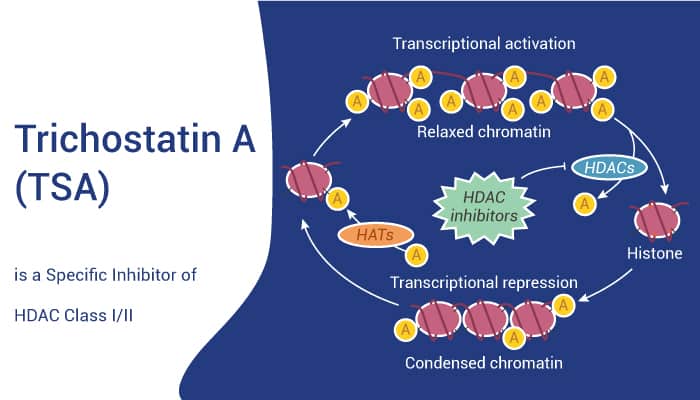Histone deacetylases (HDACs) are enzymes that remove acetyl groups from histone and non-histone proteins. To date, 18 different mammalian HDACs have been identified and divided into four classes: the Class I Rpd3-like proteins (HDAC1, HDAC2, HDAC3, and HDAC8); the Class II Hda1-like proteins (HDAC4, HDAC5, HDAC6, HDAC7, HDAC9, and HDAC10); the Class III Sir2-like proteins (SIRT1, SIRT2, SIRT3, SIRT4, SIRT5, SIRT6, and SIRT7); and the Class IV protein (HDAC11). Recently, mounting evidence points to a link between misregulated HDAC activity and many oncologic and nononcologic diseases. Notably, HDAC inhibitors can block cell proliferation, promote differentiation and induce apoptosis. Therefore, HDAC inhibitors act as antineoplastic drugs and are showing encouraging efficacy in vivo.
Class I and II HDACs belong to the HDACs classical family, share a common catalytic mechanism that requires a zinc ion. Firstly, Class I HDACs, closely related to yeast RPD3. It widely exists in the nucleus. Except for HDAC8, Class I HDACs are components of multiprotein complexes. What’s more, Class I HDACs are involved in cell proliferation and survival. Secondly, Class II HDACs, related to yeast HDA1, including subclass IIa and subclass IIb. The characteristic is the presence in their regulatory N-terminal domains of two or three conserved serine residues subject to reversible phosphorylation. Class IIb HDACs shuttle between nucleus and cytoplasm. Besides, HDAC6 is a potential therapeutic target for the treatment of an array of diseases, including neurodegenerative diseases and cancer.
Trichostatin A (TSA) is a specific inhibitor of HDAC class I/II.

Trichostatin A (TSA), an antifungal antibiotic, is a potent and specific inhibitor of HDAC class I/II. In addition, TSA can arrest cells in G1 and G2 phases of the cell cycle, induce differentiation, and revert the transformed morphology of cells in culture. Specifically, TSA exerts a potent antitumor activity on human colon carcinoma cells and breast adenocarcinoma cells. Meanwhile, TSA also inhibits the growth of esophageal squamous cell carcinoma and prostate cancer cells through the induction of cell cycle arrest and cell apoptosis. Importantly, TSA exhibits anti-tumor activity in vivo.
In conclusion, Trichostatin A is a potent and specific inhibitor of HDAC class I/II.
References:
[1]. Cottrill KA, et, al. Commun Biol. 2020 Apr 20;3(1):179.